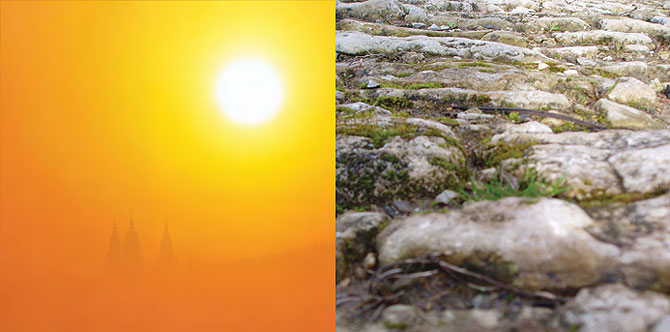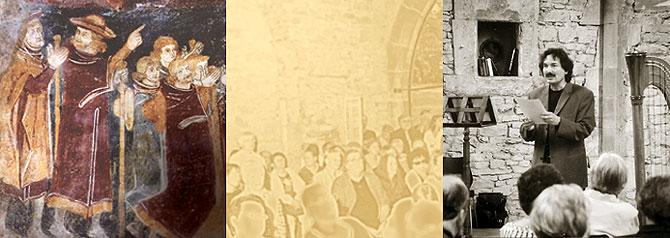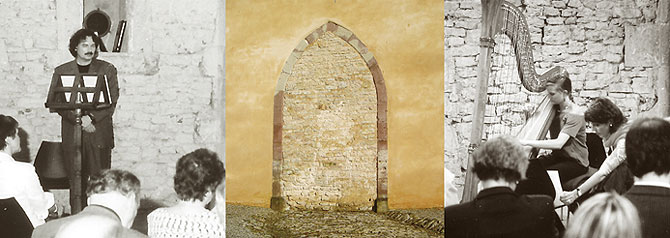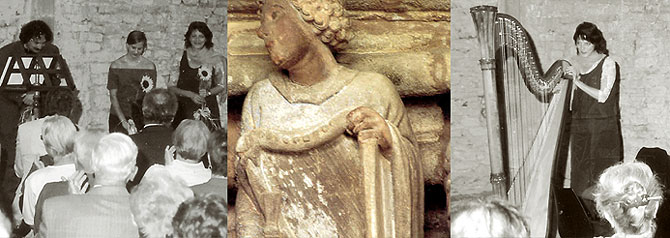summer – aestas
Paths into the light
It cannot be proven, but nevertheless I believe in it: In some places of the earth the own arrival or departure receives in a mysterious way a special intensity by the sensations of all those, who arrived here in former times or left again. Whoever has a soul that is light enough feels a gentle resistance in the air.
Cees Nooteboom, Detours to Santiago

The Wintringer Chapel also humbly joins this international circle of pilgrimage sites. Archaeological finds and the depiction of a scallop shell in a former altar retable of the "chapel" indicate that there was a place of pilgrimage here and that an ancient pilgrimage route passed by. There is much to suggest that this place was even connected to the great network of paths throughout Europe that led to one of the most important destinations of medieval pilgrimage: Santiago de Compostela. Here in northern Spain, very close to the Galician coast, a pilgrimage site had sprung up over the presumed tomb of the Apostle James, an energetic center of faith that captivated millions of people of all nations. For months and with great hardships, they traveled to implore and find salvation there.
Armin Schmitt


In our days, the great Dutch writer Cees Nooteboom has set out. With a car and a good portion of skepticism, he approached Santiago de Compostela over many years and in ever new approaches. In his famous travelogue "The Detour to Santiago" he recorded his impressions of the journey.
Excerpts from the pilgrimage travel book by Cees Nooteboom, but also texts by John the Apocalyptic, Francis of Assisi, Friedrich Hölderlin and Ingeborg Bachmann were the focus of a reading by Armin Schmitt on July 4. The texts were commented on and accompanied by Charlotte Nyborg and Christina Paulina Heer on the harp.
Armin Schmitt had compiled the texts especially for the reading in the Wintringer Chapel. Recitation and harp music not only entered into a contrasting dialogue with each other, but also with the medieval "chapel space". This created a force field that left room for thoughts, feelings and meditation.

Image detail: sculpture at the cathedral of Santiago de Compostela
MUSICAL PROLOGUE, MARCEL GRANJANY | FRIEDRICH HÄNDEL | PART 1: EXCERPT FROM THE APOCALYPSE OF JOHN | PART 2: CEES NOOTEBOOM, DETOURS TO SANTIAGO (EXCERPTS) FRANCISCO TÁRREGA, ADELITA | JOHN PARRY, SONATA D-MAJOR, 2ND AND 3RD MOVEMENT | 3. PART: MIMNERMOS, HELIOS | MESOMEDES, TO THE SUN | ORPHIC HYMN, TO THE LIGHT | JOHANN SEBASTIAN BACH, PRELUDE IN C MAJOR | FRANZ VON ASSISI, SUN HYMN | HÖLDERLIN, DEM SONNENGOTT UND GEH UNTER SCHÖNE SONNE | GARBRIEL FAURÉ, IMPROMTU | INGEBORG BACHMANN, TO THE SUN | GABRIEL FAURÈ, IMPROMTU
ARMIN SCHMITT, GERMANIST AND HISTORIAN, FORMER ARTISTIC DIRECTOR OF THE "SCHICHTWECHSEL" FESTIVAL AT THE VÖLKLINGER HÜTTE | CHARLOTTE NYBORG, SOLO HARPIST AT THE STATE THEATER IN SAARBRÜCKEN | CHRISTINA PAULINA HEER, HARPIST, SWITZERLAND
